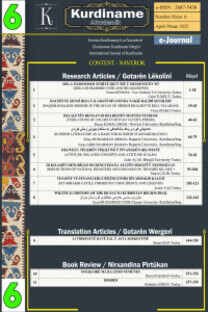KURD DI TÂCU’L-‘ERÛS’Ê DE
KÜRTÇE, kürt edebiyatı, kürt tarihi
KURDS IN TÂJ AL-‘ARÛS
___
- ‘Attar Ehmed Abdulğafûr (1984), Muqaddimetu’s-Sihâh, Beyrut, Dâru’l-‘İlim Li’l-Melâyîn.
- El-Birmâvî, Şemsuddîn (2012) El-Lâmi‘U’s-Sabîh Bi Şerhi Câmi‘İ’s-Sahîh, Thk., Heyet, Suriye, Dâru’n-Nevâdir,
- El-Fîrûzabadî, Muhemmed B. Yaqûb (2005), El-Qâmûsu’l’elâm, Beyrut, Mussesetu’r-Rîsale.
- El-Hemevî, Yâqût Ebdullah-: Mucemu’l-Buldân, Beyrut, Dâru’l-Fikr,
- İbn Hecer El-‘Esqelânî, Ahmed B. Ali-: Tebsîru’l-Muntebih, Thq., Muhemmed ‘Eli En-Neccâr, Beyrut, Mektebetu’l-‘İlmiyye.
- İbn Xellikân, Şemsuddîn Ehmed (1994), Wefeyâtu’l-‘Eyân Ve Enbâu Ebnâi’z-Zâmân, Beyrut, Dâru Sâdr.
- İbn Şeddâd-Muhemmed B. ‘Elî-, El-‘Alâqu’l-Hatire Fî Zikri Umeraî’ş-Şâmi Ve’l-Cezîre,- ,-
- Kâtib Çelebî, Mustafa B. Ebdillah (2010), Sulemu’l-Vusûl İlâ Tabaqâti’l-Fuhûl, Thk., Mahmûd Abdulkadir El-Arnâvut, İstanbul, Mektebetu İrsica.
- Kehhâle-, Umer Rıza-, Mu‘Cemu’l-Muellifîn, Beyrut, Mektebetu’l-Musennâ.
- El-Kûrânî, Ehmed B. İsmail (1928), El-Kevseru’l-Cârî İlâ Riyâdi Ehâdisi’l-Buxârî, Thq., Ehmed ‘İzz Û İnâye, Beyrut, Dâru İhyâi’t-Turâsi’l-‘Erebiyye.
- Sâmî, Şemseddin (1903), Qâmûsu’l-A‘Lâm, İstanbul.
- Ez-Zebîdî-, Muhemmed B. Muhemmed, Tâcu’l-‘Arûs Min Cevâhiri’l-Qâmûs, Thk., Heyet, Dâru’l-Hidâye.
- Ez-Zîriklî-, Xeyruddîn, El-‘Elâm, Dâru’l-‘İlim Li’l-Melâyîn, Byy.
- ISSN: 2687-5438
- Yayın Aralığı: Yılda 2 Sayı
- Başlangıç: 2019
- Yayıncı: Osman ASLANOĞLU
PATRONAJ, EĞITIM, TOPLUMSAL ROL VE BAKIŞ VE SANATI İCRA ETME YÖNÜNDEN KADININ DENGBÊJLİĞİ
میتۆدە نوێیەکانی فێرکردنی زمانی دووەم و کاریگەرییان لەسەر زمانی کوردی
MS GULPĀYGĀNĪ 1246: A CONTINUATION TO THE ARDALĀN CHAPTER OF SHARAF-NĀMA
NIRXANDINA ÇANDA QUBEDEYÊN DIYARBEKIRÊ LI GOR QALIBA EŞQIYAYÊN CIVAKÎ YA ERIC HOBSBAWM
DI DÎWANA PERTO BEGÊ HEKKARÎ DE POR
KURDISH LANGUAGE, ITS FAMILY AND DIALECTS
Hewa S. KHALİD, Çevirmen: Hewa S. KHALİD
DAHÛRANDINA ÇîROKA “EHMEDÊ ZEYDAN” LI GOR RÊBAZA MORFOLOJÎK A VLADIMIR PROPP
ERGATÎVÎ DI KURDIYA KURMANCÎ DE Û REWŞÊN AWARTE YÊN ERGATÎVIYA KURMANCÎ
